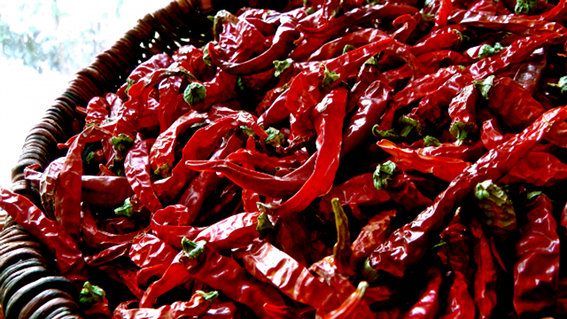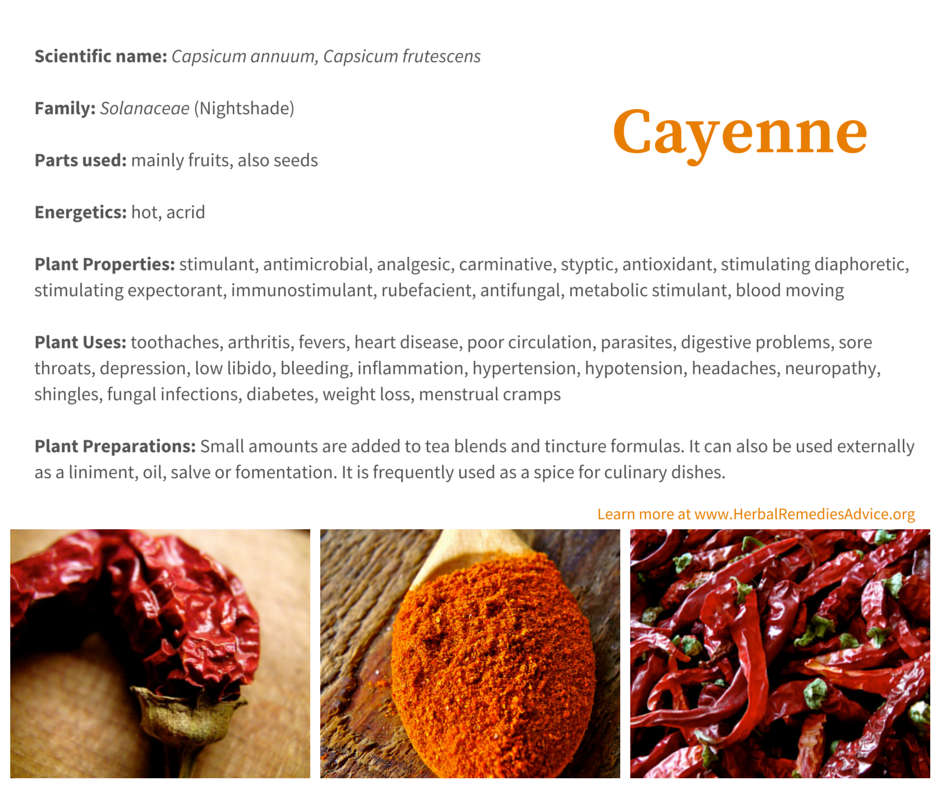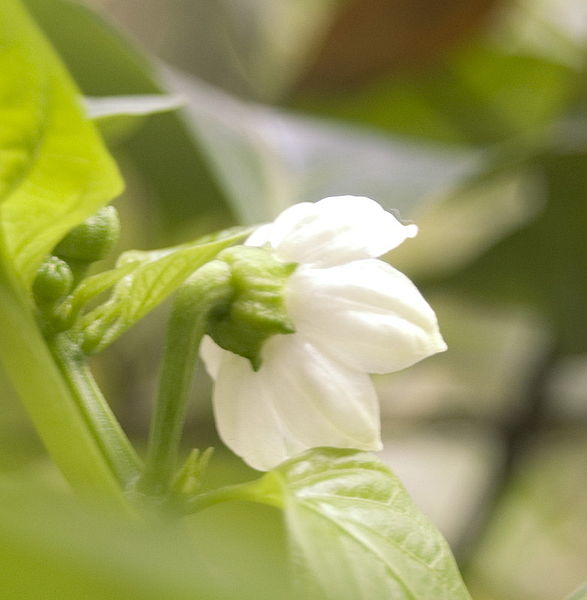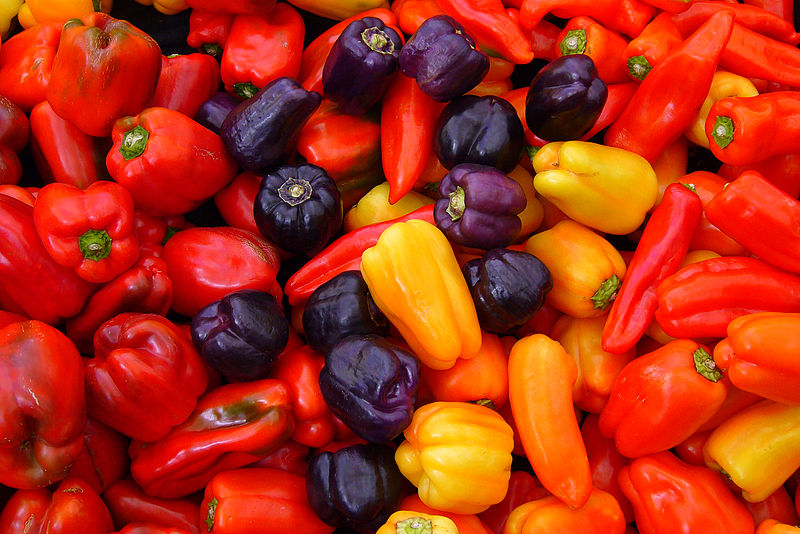Get weekly tips, recipes, and my Herbal Jumpstart e-course! Sign up for free today.

Cayenne Pepper Benefits
Share this! |
|
|
Cayenne comes from the Capsicum genus, which also includes bell peppers, chilies, paprikas and habaneros. This genus is from the Americas and has been cultivated for use for at least 7,000 years. Some of the early european explorers brought the seeds from South America back to Europe and they quickly spread around the world. The first part of this article will focus on general cayenne pepper benefits and information. The second part will focus on the health benefits of cayenne pepper in herbalism. |
Capsicum is not a cure all, but you are missing the boat if you are not using it.
-Dr. Douglas Kirkbride
If you master only one herb in your life, master cayenne pepper. It is more powerful than anything else.
-Dr. Richard Shulze
Capsicums vs Peppers
Cayenne is often commonly referred to as a pepper, but it is not in the Piper genus (such as black pepper and kava). The common word “chili” is often used for cayenne and other Capsaicin genus plants. This word is said to come from the Aztecs.
The etymology of the word Capsicum is believed to have been derived from Greek, meaning “to bite”.
Botanically Speaking
|
Capsicum plants are small shrubs. In tropical environments C. frutescens can be a perennial plant living for a decade or longer while C. annuum is an annual or biennial. In northern climates they are cultivated as annuals. The bright red “pepper” is often thought of as a vegetable but is actually the fruit of the plant. |
What Makes Cayenne Pepper Bite?
Cayenne has a hot and acrid taste. This “bite” is caused by the constituent capsaicin. The more capsaicin a pepper has the more heat or bite it has. This amount varies greatly between species and varieties.
One method of measuring this bite or heat is the Scoville heat units (SHU). Cayenne has around 30,000 – 50,000 SHU. In contrast, bell peppers have 0 and habaneros have more than 100,000.
Evolutionary biology explains that the red fruit of capsicums attracts birds who seemingly love the fruit and are not affected by the hot taste. They then distribute the seeds. All mammals experience the bite of Capscium species.
Many scientific studies use capsaicin as a standard isolated extract rather than using the whole cayenne herb.
Cayenne Herb Energetics
Energetically, cayenne is very intense. For the most part, our food-like herbs are balanced energetically. This means that their thermal temperature (cold to hot) is somewhere around neutral and their humidity level (moist to dry) is around neutral. This lets us know that they can be consumed in food-like quantities for long periods of time with beneficial results.
Let’s take a basic energetic understanding of nettle for instance.
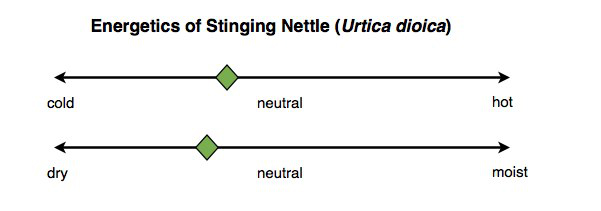
My interpretation of nettle is that it tends to be a bit cooling and a little bit more drying but, all in all, it is fairly close to neutral.
If we drew cayenne in the same way it would look more like this:
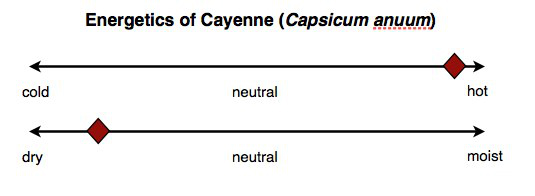
Compared to stinging nettle, cayenne is considerably more dramatic energetically. It is one of our hottest plants and is quite dry as well.
The further an herb is to one or the other side of the scale, the more tendency it has to create unwanted effects. These more intense herbs tend to be our medicinal herbs and they are best consumed in small amounts and in formulas that help to balance the effects.
Can you imagine eating a bowl of nettle soup? How about a bowl of nettle soup for dinner and for lunch? Yum! Can you imagine eating a bowl of cayenne soup? That’s the point I am trying to make.
You could probably eat a bowl full of cooked nettles for the rest of your life and only receive good benefits from it. If you somehow managed to eat a bowl of cayenne peppers one day, you probably couldn’t continue that practice day after day because pretty soon unwanted effects like an upset tummy and gastric heat would begin to occur.
Granted, when a lot of peppers are consumed they create an endorphin rush in the body, creating a euphoric state of mind. Some people build a threshold for this experience and can increasingly eat more and more peppers.
However, for the most part, cayenne is used in food and in formulas in very small amounts.
Samuel Thompson
In the herbal world it is impossible to mention cayenne without tipping our hats to Samuel Thompson. Thompson is a main figurehead in North American herbal history who lived from 1769 to 1843. He learned about herbs from a widow and became a dedicated herbalist after watching his family suffer at the hands of the doctors of the time. One of his favorite and most-used herbs was cayenne. He considered it a stimulant above all, and used it for stagnant depression and stagnant digestion.
Thompson believed that coldness was a major contributing factor to disease. Steam baths and cayenne were two of his mainstays for creating a person’s inner heat.
After
much experience and trying every thing within my knowledge, to gain
this important point, I fixed upon the medicine which I have called No. 2
[Cayenne, Capsicum spp.], in my patent, for that purpose; and after
using it for many years, I am perfectly convinced that it is the best
thing that can be made use of to hold the heat in the stomach until the
system can be cleared of obstructions, so as to produce a natural
digestion of the food, which will nourish the body, establish
perspiration and restore the health of the patient. I found it to be
perfectly safe in all cases, and never knew any bad effects from
administering it.
- Samuel Thompson
Continue to part 2 for the health benefits of cayenne pepper.

Rosalee is an herbalist and author of the bestselling book Alchemy of Herbs: Transform Everyday Ingredients Into Foods & Remedies That Healand co-author of the bestselling book Wild Remedies: How to Forage Healing Foods and Craft Your Own Herbal Medicine. She's a registered herbalist with the American Herbalist Guild and has taught thousands of students through her online courses. Read about how Rosalee went from having a terminal illness to being a bestselling author in her full story here.
